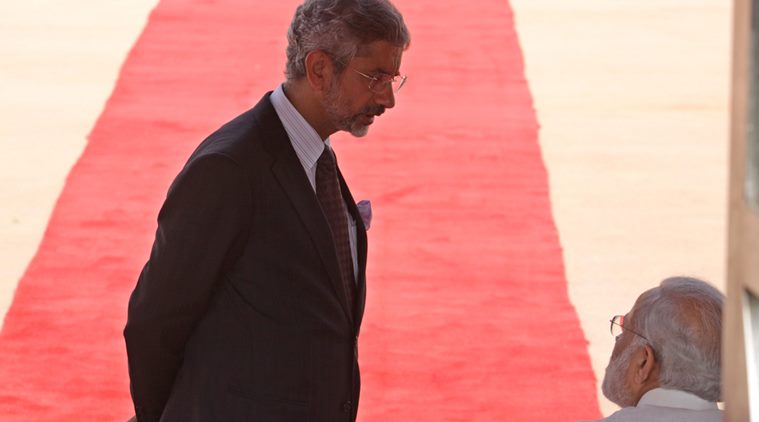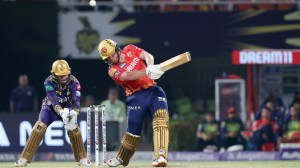- India
- International
After NSG upset, India set to become member of MTCR
Admission to MTCR will open the way for India to buy high-end missile technology, also making more realistic its aspiration to buy surveillance drones such as the Predator, made by General Atomics.
 Foreign Secretary S Jaishankar is all set to sign the instrument of accession into MTCR, which could happen as early as on Monday, in a ceremony to be attended by the MTCR chair troika. (Source: Express Photo by Praveen Jain/ File)
Foreign Secretary S Jaishankar is all set to sign the instrument of accession into MTCR, which could happen as early as on Monday, in a ceremony to be attended by the MTCR chair troika. (Source: Express Photo by Praveen Jain/ File)
Notwithstanding the failure of its ambitious bid to become a part of the Nuclear Suppliers Group (NSG), India is all set to become a member of the Missile Technology Control Regime (MTCR) next week — one of the four export control regimes of which Delhi has been aspiring to become a member.
The Sunday Express has learnt that Foreign Secretary S Jaishankar is all set to sign the instrument of accession into MTCR, which could happen as early as on Monday, in a ceremony to be attended by the MTCR chair troika — envoys from France, Netherlands and Luxembourg. The MTCR chair troika comprises the past, incumbent and future chair of the group.
“Membership of one export control regime can be reinforcing on others, since India’s credentials are vetted in one and the remaining three can follow the example,” said an Indian official.
[related-post]
Watch Video: What’s making news
India’s efforts to become a member of the MTCR began after the Indo-US nuclear deal in 2008. New Delhi has been keen to become a member of the four export control regimes — MTCR, NSG, Australia Group and Wassenaar Arrangement. But with the nuclear deal stuck over liability issues, New Delhi’s bid to become a member of MTCR only gained momentum from April 2015, after the liability issue was resolved and the US lent its full support.
The government made its case in June and October last year, but Italy raised objections in the 34-member grouping — membership is decided by consensus (like NSG) — since it was upset with India over the Italian marines dispute. With both the marines being allowed to return to their country, Rome has dropped its objections.

India’s application was thus admitted and there were no objections from any MTCR member under the “silent procedure”. According to the “silent procedure”, a 10-day period is given by the chair for raising objections. If there are no objections, the new member can be admitted.
The members of this international non-proliferation regime agreed to admit India early this month, coinciding with Prime Minister Narendra Modi’s visit to the US.
Admission to MTCR will open the way for India to buy high-end missile technology, also making more realistic its aspiration to buy surveillance drones such as the Predator, made by General Atomics.
India makes a supersonic cruise missile, the Brahmos, in a joint venture with Russia that both countries hope to sell to third countries, a development that would make India a significant arms exporter for the first time.
Membership of the MTCR would require India to comply with rules, such as a maximum missile range of 300 km, that seek to prevent arms races. Interestingly, China is not a member of the MTCR, although it voluntarily decided to adhere to the regime’s guidelines. Its application in 2004 was rejected, following allegations of it supplying missile technology to North Korea.
After becoming a member of the MTCR, India can hold the key to blocking China’s membership in the future — a leverage, many feel, could be used to get Beijing to lift its objections to India’s membership to the NSG.
Established in April 1987 by G7 countries (Canada, France, Germany, Italy, Japan, Great Britain and the US), the MTCR is an informal and voluntary partnership to prevent proliferation of missiles and unmanned aerial vehicle technology capable of carrying a 500-kg payload over 300 km or more.
In 2002, the MTCR was supplemented by the International Code of Conduct against Ballistic Missile Proliferation (ICOC), which calls for restraint and care in proliferation of ballistic missile systems capable of delivering weapons of mass destruction and has 119 members. The ICOC is also referred to as ‘The Hague Code of Conduct’ (HCOC) against ballistic missile proliferation, which is considered to be complementary to the MTCR.
India agreed to adhere to the Hague Code of Conduct in early June, as the MTCR was considering its application.
Apr 26: Latest News
- 01
- 02
- 03
- 04
- 05







































